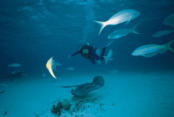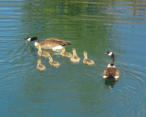



G












VISION
Biodiversity

The Vision of Biodiversity
Resources
Center for Biological Diversity
http://www.biologicaldiversity.org/index2.html
Vast expanses of tree farms and regrowth forests built on top of once pristine old growth forests are not true
renewable resources; don’t buy into the sugar-coated pseudo-green talk found around places like coastal Oregon
today!
Valuing species diversity is absolutely one of the key issues on this website. Too many people in our society today are
ignorant of or turn their attention away from this vital concept. It is a major stimulus behind everything else being said and
promoted across all sections of the website. It indicates simply that wild nature left unchecked is a value on various levels. It
includes the idea that plants, trees, animals and other life forms are important and should not be turned into farms, gardens,
renewable forests, parking lots, subdivisions, commercial enterprises, condominiums, or houses. This vision communicates
the idea that the healthiest life forms do not sustain a thriving existence in planted or neatly planned and organized form; we
have to keep the wild around or life on this planet - including human life - will end.
This vision encourages people to see loveliness and value in natural world connections and to seek more refined forms of
economic vitality, health and practicality. It promotes the idea that things left untouched and moving along natural lines of
evolution help the entire planet, including humans. Species diversity offers a buffer against wipe-outs of genetic lines in
particular and life in general by permitting the opportunity for multiple chances of success among various species populations.
In addition, creatures interconnect in ways often unknown or fully understood and when we take away parts, we often destroy
the health and vitality of the whole.
Natural forests chopped down and replaced by tree farms and regrowth forests are not, and never will be, truly renewable
resources. The original source - the natural forest - was not renewable, so everything that comes after that should not be
seen as somehow better, and the original forests should not be forgotten; do not permit socially induced amnesia to diminish
memory of those once grand forests. Do not take lightly when people tell you “it’s a sensitive topic” and that the tree farms
and regrowth forests are a “renewable resource” and that they help the area by giving lots of people jobs. That is a cop-out.
It is a low end form of intelligence to look for jobs in such environmentally harsh ways without really thinking things through to
figure out solutions for sustainable employment. Areas that retain their original forests carry a vitality and aesthetic appeal
which supports the economy in other ways than just the large-scale brute labor of maintaining and cutting down trees; they
also tell visitors that the region’s people are good stewards worth investing the future in. It’s not just about developing and
supporting a tourism industry; quality aesthetics as found in nature and lovely cities and towns draws tourists but also
encourages long-range economic planning and development.
People who are doing smart and lovely things with their associated land and resource areas tell other like-minded people to
come and stay for the value of smart living choices and quality of life. The true glory and beauty of the Oregon, California and
Washington’s coasts have been mostly ruined by the avaricious clear-cutting of the natural forests along the coastal areas
there. It is because people did not want to take the time to develop their people’s livelihoods in better ways and allowed
things to run amuck. The privatization of forest land was a major issue, but it was also the cultural background of the coastal
inhabitants which permitted this wide-scale destruction. The culture gave the permission. The way people think and process
information in an area allowed for the problems to develop and then did not stop them in time until it was too late. People in
these areas shot themselves in the foot by ignoring that raw nature and beauty are in fact powerful assets - and allies - and
should not be taken lightly.
Areas which show intelligence draw intelligence; keeping nature intact around developed areas while educating the population
for higher end ways of making a living promotes further inspiration. Enjoying and respecting nature is the way to go in today’s
world. It is the upscale economics approach to long-term success and survival. Do not support brute force anti-environmental
tactics; support education, aesthetics and quality of life. Use intelligence to figure out ways for everyone in the area to have a
job! Be smart about what work looks and feels like! Don’t settle for low end approaches which pretend to be long-term
solutions. Consider employment with quality of life the primary objective! When people make up their minds to be smart,
they are smart! It’s what we give ourselves permission for that counts - if we give ourselves permission to think up non-
environmentally harmful ways to make a living for everyone, we can do it! We don’t have to buy into hard times as a reason
for killing off the planet to stay economically afloat.
Destroying natural forests in large degree only to replant with trees for lumber company usage is a form of deprivation on a
tremendous scale. To call these approaches anything other than environmental deprivation is sugar-coating the issue.
This is because in modern times forest depletion has already occurred in huge proportion and continues to occur at a
tremendous rate. What forests are left are rare and precious, and are also often greatly threatened by disease, fire, drought,
insect invasion and other problems. The wild qualities in these forests need to be given an opportunity to remain so by
allowing the natural forces and themes of species diversity free reign on the inner and outer forms of the life forms there.
People who don’t understand the idea that species diversity is both a protection for global health as well as an economic asset
should not be running the show.
Education and value system reshaping should be seen as part of the species diversity vision for the nation and planet as a
whole. More people need to see and promote this vision. Do not support school systems and political tactics in an area which
suggest that people should not talk about the problems associated with fossil fuels, deforestation and other environmental
destructive practices because the topics are “too sensitive.” This is part of the wall of silence designed to protect certain
interests. Also consider ways to do the best we can to clean up what has already been taken way, destroyed or polluted. We
can never convert a tree farm or regrowth forest back into a natural old growth forest, but we can attempt to restore some form
of diversity in these areas. This can include thinning out the often thickly planted trees (currently lined up in rows, all the same
size, thickness and age), replanting other forms of natural vegetation and returning native animal populations to the area.
updated 3/8/2015




- INDEX - environment
- INDEX resources
- Animal Issues
- Env. concerns SW
- Fukushima
- Fukushima website links-summary
- Recycling
- Water
- Renewable energy
- water issues
- sustainable practices
- Connecting for Conservation
- Libraries & Museums
- Media In Area
- Museums & Archaeology
- Food Competence & Gardening
- Oregon Coast Deforestation
- Schools Nature, Biology, Etc.
- Resources General Environmental
- Solar pros & cons
- Land Use









